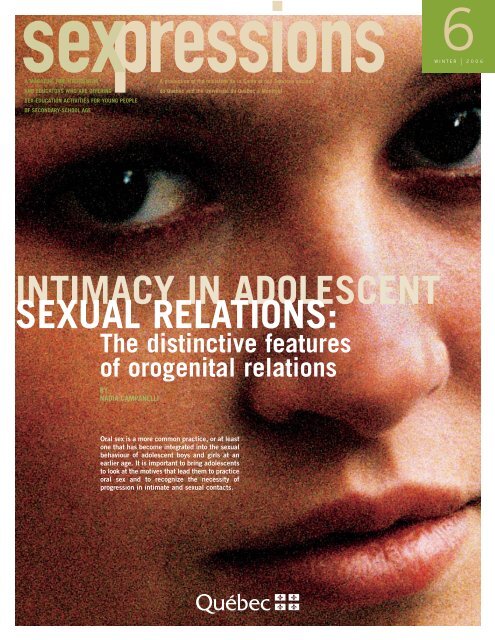Intimacy in adolescent sexual relations - MSSS/Notice/Copyright ...
Intimacy in adolescent sexual relations - MSSS/Notice/Copyright ...
Intimacy in adolescent sexual relations - MSSS/Notice/Copyright ...
You also want an ePaper? Increase the reach of your titles
YUMPU automatically turns print PDFs into web optimized ePapers that Google loves.
6<br />
WINTER | 2006<br />
A MAGAZINE FOR INTERVENERS<br />
AND EDUCATORS WHO ARE OFFERING<br />
SEX-EDUCATION ACTIVITIES FOR YOUNG PEOPLE<br />
OF SECONDARY-SCHOOL AGE<br />
sexpressions<br />
A production of the m<strong>in</strong>istère de la Santé et des Services sociaux<br />
du Québec and the Université du Québec à Montréal<br />
INTIMACY IN ADOLESCENT<br />
SEXUAL RELATIONS:<br />
The dist<strong>in</strong>ctive features<br />
of orogenital <strong>relations</strong><br />
BY<br />
NADIA CAMPANELLI<br />
Oral sex is a more common practice, or at least<br />
one that has become <strong>in</strong>tegrated <strong>in</strong>to the <strong>sexual</strong><br />
behaviour of <strong>adolescent</strong> boys and girls at an<br />
earlier age. It is important to br<strong>in</strong>g <strong>adolescent</strong>s<br />
to look at the motives that lead them to practice<br />
oral sex and to recognize the necessity of<br />
progression <strong>in</strong> <strong>in</strong>timate and <strong>sexual</strong> contacts.
THE DISTINCTIVE FEATURES OF OROGENITAL RELATIONS<br />
I sexpressions<br />
C h a r l o t t e , w h o i s 1 3 y e a r s o l d , k n o w s t h a t h e r f r i e n d C a s s a n d r a r e g u l a r l y<br />
p e r f o r m s f e l l a t i o o n a b o y. C h a r l o t t e d o e s n ’ t a g r e e w i t h t h i s p r a c t i c e . W h e n s h e<br />
l e t C a s s a n d r a k n o w w h a t s h e t h o u g h t , t h e l a t t e r a n s w e r e d : “A n y w a y, o r a l s e x<br />
i s n ’ t r e a l l y s e x . ” C a s s a n d r a a l s o a d d e d t h a t C h a r l o t t e s h o u l d d o t h e s a m e t h i n g<br />
b e c a u s e t h e n t h e b o y s w o u l d c o n s i d e r h e r t o b e ‘ h o t ’ .<br />
Scenario <strong>in</strong>spired by episode No. 115 of the soap opera Un monde à part, broadcast on Radio-Canada on 29 September 2004<br />
What do you th<strong>in</strong>k of this situation? Where, <strong>in</strong> your view, lies the problem? What do you th<strong>in</strong>k of Cassandra’s<br />
attitude? What do you th<strong>in</strong>k of her view of the practice of oral sex?<br />
sexpressions<br />
N O 6, WINTER 2006<br />
THIS MAGAZINE IS A COLLABORATIVE<br />
PRODUCTION BY:<br />
the m<strong>in</strong>istère de la Santé et<br />
des Services sociaux du Québec<br />
- Direction des communications<br />
- Direction générale de santé publique<br />
• Richard Cloutier<br />
- Direction générale des services sociaux<br />
• Anik Simard<br />
and the Université du Québec à Montréal<br />
- Nadia Campanelli, sexologist,<br />
Master’s student <strong>in</strong> sexology<br />
- Franc<strong>in</strong>e Duquet,<br />
professor <strong>in</strong> the Department of Sexology<br />
We thank Bianka Champagne, Master’s student<br />
<strong>in</strong> sexology at UQAM, for her helpful comments.<br />
Translation and revision: Sean McCutcheon<br />
(Science Communication group) and Sylvie Gauthier<br />
Graphic design: Immaculæ conception graphique<br />
The photographs <strong>in</strong> this magaz<strong>in</strong>e are used only to<br />
illustrate the topics discussed here<strong>in</strong>. The people<br />
that appear <strong>in</strong> them are models.<br />
You can f<strong>in</strong>d issues of Sexpressions, a magaz<strong>in</strong>e<br />
about sex education, on the Website of the m<strong>in</strong>istère<br />
de la Santé et des Services sociaux du Québec at<br />
www.msss.gouv.qc.ca/itss by click<strong>in</strong>g English and<br />
then Sexpressions. Sexpressions is also available<br />
<strong>in</strong> French under the name Ça sexprime.<br />
Oral sex seems to have become a more common practice, or at least one that has become <strong>in</strong>tegrated <strong>in</strong>to<br />
the <strong>sexual</strong> behaviour of <strong>adolescent</strong> boys and girls at an earlier age. 1 This, no doubt, is due to the fact that<br />
this practice has become commonplace, particularly <strong>in</strong> magaz<strong>in</strong>es for <strong>adolescent</strong> girls. Such magaz<strong>in</strong>es no<br />
longer talk about the signs show<strong>in</strong>g that a boy is <strong>in</strong>terested <strong>in</strong> a girl, but rather about the tricks that can<br />
help him reach the seventh heaven. “Young girls confide that they have practiced fellatio <strong>in</strong> the pseudo<strong>in</strong>timacy<br />
of a toilet stall, while at the same time reveal<strong>in</strong>g that they have never kissed a boy” (Chou<strong>in</strong>ard, 2005).<br />
However, accord<strong>in</strong>g to Jocelyne Robert (2005, p.117), a kiss is “an act that fundamentally <strong>in</strong>volves an<br />
<strong>in</strong>timate <strong>relations</strong>hip”. In other words, they jump directly to this <strong>sexual</strong> practice even though, a priori, kiss<strong>in</strong>g<br />
seems less <strong>in</strong>timate. It also seems that the motivations beh<strong>in</strong>d the practice of oral sex are <strong>in</strong>congruent with<br />
the notion of <strong>in</strong>timacy be<strong>in</strong>g necessary for progression <strong>in</strong> the nature of <strong>sexual</strong> contact.<br />
In fact, as we will see, <strong>adolescent</strong>s do not necessarily see oral sex as constitut<strong>in</strong>g a <strong>sexual</strong> practice nor,<br />
moreover, do they immediately take <strong>in</strong>to account the risks that might be associated with it. In tackl<strong>in</strong>g the<br />
theme of oral sex, this magaz<strong>in</strong>e wishes to show the importance of sensitiz<strong>in</strong>g <strong>adolescent</strong>s to the necessity of<br />
reconsider<strong>in</strong>g the motives that lead them to practice oral sex, to the necessity of progression <strong>in</strong> <strong>in</strong>timate<br />
and <strong>sexual</strong> contacts and, above all, to the particularly <strong>in</strong>timate character of the practice of oral sex.<br />
The practice of oral sex by <strong>adolescent</strong>s<br />
is a subject that may make a number of people uncomfortable<br />
given the <strong>in</strong>timate nature of this <strong>sexual</strong> behaviour.<br />
If you f<strong>in</strong>d it awkward to raise this subject with <strong>adolescent</strong>s,<br />
you would, no doubt, f<strong>in</strong>d the support of a sexologist helpful.<br />
Do not hesitate to call upon other qualified people<br />
with<strong>in</strong> the school system for this k<strong>in</strong>d of <strong>in</strong>tervention. 2<br />
Legal deposit<br />
Bibliothèque nationale du Québec, 2006<br />
National Library of Canada, 2006<br />
ISSN 1718-4231 (Pr<strong>in</strong>t version)<br />
ISSN 1718-522X (PDF version)<br />
Reproduction, <strong>in</strong> whole or <strong>in</strong> part, of this document<br />
is permitted on condition that the source is credited.<br />
© Gouvernement du Québec, 2006<br />
1. By oral sex we mean “all k<strong>in</strong>ds of <strong>sexual</strong> practices <strong>in</strong>volv<strong>in</strong>g the mouth or the tongue” (Tremblay, 2004) of one person and the genital organs of another person. Oral sex<br />
performed on a man is called fellatio. Oral sex performed on a woman is called cunnil<strong>in</strong>gus. Moreover, we use the terms receiv<strong>in</strong>g or giv<strong>in</strong>g oral sex to dist<strong>in</strong>guish the respective<br />
roles of the partners <strong>in</strong>volved <strong>in</strong> oral sex: the person who gives oral sex is the active partner and the person who receives it is the passive partner (Canadian AIDS Society, 2005).<br />
2. In schools, the staff of complementary educational services (the staff member <strong>in</strong> spiritual care and guidance and community <strong>in</strong>volvement services, the nurse, etc.) through<br />
the prevention and promotion programme, may contribute either by collaborat<strong>in</strong>g with the teacher or offer<strong>in</strong>g extracurricular animation, for example.
INTIMACY AND SEXUALITY<br />
S<strong>in</strong>ce the presence or absence of <strong>in</strong>timacy has a direct <strong>in</strong>fluence on<br />
the nature of the contacts between partners, there is good reason to<br />
deal with the idea of <strong>in</strong>timacy <strong>in</strong> <strong>sexual</strong> <strong>relations</strong> <strong>in</strong> general before<br />
deal<strong>in</strong>g more specifically with the practice of oral <strong>relations</strong> between<br />
<strong>adolescent</strong>s.<br />
<strong>Intimacy</strong> can be described with the help of certa<strong>in</strong> key terms such as<br />
the motivation to seek <strong>in</strong>timacy, and capacity and tolerance for<br />
<strong>in</strong>timacy. Accord<strong>in</strong>g to McAdams (1980), the motivation to seek<br />
<strong>in</strong>timacy reflects a yearn<strong>in</strong>g for warm exchanges <strong>in</strong> which <strong>in</strong>timacy<br />
itself represents a goal. For Schnarch (1991), it is a question of a need<br />
for <strong>in</strong>terpersonal contacts l<strong>in</strong>ked to tolerance for <strong>in</strong>timacy. As for Reis<br />
and Shaver (1988), they present <strong>in</strong>timacy as an <strong>in</strong>terpersonal process<br />
<strong>in</strong> which <strong>in</strong>teraction between two partners is based on the partners’<br />
experiences and the expressions of their feel<strong>in</strong>gs. These <strong>in</strong>teractions<br />
occur with the help of both verbal and non-verbal communication,<br />
and allow people to get closer to each other, which opens the door for<br />
them to be open about themselves.<br />
Prager (1995) proposes a multi-layered concept of the capacity for<br />
<strong>in</strong>timacy. She translates this concept <strong>in</strong>to <strong>in</strong>timate <strong>in</strong>teractions and<br />
<strong>in</strong>timate <strong>relations</strong>hips.<br />
consciousness, and of risk<strong>in</strong>g the open<strong>in</strong>g up of your own consciousness<br />
through encounter with another consciousness.” He adds that<br />
“<strong>in</strong>timacy also requires authentic personhood, the capacity to consult<br />
one’s <strong>in</strong>ternal frame of references, self confidence and confidence <strong>in</strong><br />
the other, as well as a good dose of humility so as not to impose one’s<br />
own view on the other.” The <strong>in</strong>ternal frame of reference comprises an<br />
<strong>in</strong>dividual’s values, perceptions, op<strong>in</strong>ions, and so on.<br />
The k<strong>in</strong>d of <strong>in</strong>timacy advocated <strong>in</strong>volves an <strong>in</strong>terpersonal process and<br />
<strong>in</strong>teraction between two partners that <strong>in</strong>cludes emotional closeness,<br />
shar<strong>in</strong>g, and self revelation. More than anyth<strong>in</strong>g else, <strong>in</strong>timacy is a<br />
matter of the presence of a feel<strong>in</strong>g of well-be<strong>in</strong>g and of confidence<br />
<strong>in</strong> the affective, perceptive, and cognitive realms, before, dur<strong>in</strong>g and<br />
after exchanges.<br />
The practice of oral sex implies, therefore, a certa<strong>in</strong> <strong>in</strong>timacy with<br />
more or less commitment on the <strong>in</strong>terpersonal and emotional levels.<br />
We will discuss this later. But what about the frequency of oral sex<br />
among the young?<br />
Intimate <strong>in</strong>teractions are the verbal or non-verbal exchanges between<br />
two persons <strong>in</strong> which one or both partners share someth<strong>in</strong>g private or<br />
personal with the other. Intimate <strong>in</strong>teractions are based on a feel<strong>in</strong>g<br />
of affective, perceptive and cognitive well be<strong>in</strong>g before,<br />
dur<strong>in</strong>g and after the exchanges.<br />
Intimate <strong>relations</strong>hips, imply <strong>relations</strong>hips that last<br />
some time and are characterized by a history of<br />
repeated <strong>in</strong>timate <strong>in</strong>teractions. They are also<br />
characterized by affection, trust, and oneness.<br />
Thériault (1995) makes it clear that the capacity<br />
for <strong>in</strong>timacy, which reflects <strong>in</strong>tra-psychic<br />
<strong>in</strong>timacy, allows the <strong>in</strong>clusion of notions of<br />
emotional proximity, shar<strong>in</strong>g, self-revelation,<br />
and experiences that are especially connected<br />
with <strong>in</strong>timacy. In other words, when two people<br />
reveal themselves to each other by shar<strong>in</strong>g their<br />
feel<strong>in</strong>gs and emotions, a psychological proximity is<br />
created that allows these persons to experience<br />
<strong>in</strong>timacy. As for Bureau (1995, p. 2), he stresses that “the<br />
capacity for <strong>in</strong>timacy enhances [...] the special ability of<br />
nam<strong>in</strong>g and express<strong>in</strong>g all that there is <strong>in</strong> your subjective<br />
3
THE DISTINCTIVE FEATURES OF OROGENITAL RELATIONS<br />
I sexpressions<br />
THE PRACTICE OF ORAL SEX AMONG ADOLESCENTS<br />
A study of <strong>sexual</strong> health, HIV, and AIDS <strong>in</strong> young<br />
people published by the Council of M<strong>in</strong>isters of<br />
Education, Canada (CMEC) <strong>in</strong> 2003, showed that <strong>in</strong><br />
secondary III, 28% of girls and 32% of boys had had<br />
orogenital <strong>relations</strong>, while 19% of girls and 23% of boys<br />
had had <strong>sexual</strong> <strong>relations</strong>hips with vag<strong>in</strong>al penetration.<br />
Still accord<strong>in</strong>g to the same study, 53% of boys and 52% of<br />
girls <strong>in</strong> secondary V had had orogenital <strong>relations</strong> at least<br />
once, while 40% of boys and 46% of girls had had <strong>sexual</strong> <strong>relations</strong>hips<br />
with vag<strong>in</strong>al penetration at least once.<br />
Various studies carried out <strong>in</strong> the United States on a large group of<br />
boys aged 15 to 19 years have recorded an <strong>in</strong>crease <strong>in</strong> the practice<br />
of oral sex, and especially of fellatio, s<strong>in</strong>ce the end of the 1980s (Gates<br />
and Sonenste<strong>in</strong>, 2000; Schwartz, 1999). From then on, not only did the practice<br />
of oral sex become more common, but it also became more frequent<br />
than vag<strong>in</strong>al penetration (Halpern-Felsher et al., 2005). This claim agrees<br />
with data gathered by different authors, which reveal that 7% to<br />
24% of <strong>adolescent</strong> boys and girls who are still virg<strong>in</strong>s have had oral<br />
sex, either giv<strong>in</strong>g or receiv<strong>in</strong>g this k<strong>in</strong>d of fondl<strong>in</strong>g (Newcomer and Udry,<br />
1985; Breakwell and Fife-Shaw, 1992; Schuster, Bell, and Kanouse, 1996; Gates and<br />
Sonenste<strong>in</strong>, 2000).<br />
And while on this subject, the number of partners constitutes<br />
another important element to consider. Among <strong>adolescent</strong>s, it<br />
is higher for oral sex than for <strong>sexual</strong> <strong>relations</strong> with vag<strong>in</strong>al<br />
penetration (Pr<strong>in</strong>ste<strong>in</strong> et al., 2003).<br />
Furthermore, <strong>adolescent</strong>s seem to believe that there are fewer<br />
risks <strong>in</strong> terms of physical and emotional health with oral sex<br />
than with vag<strong>in</strong>al penetration (Halpern-Felsher et al., 2005). What is<br />
more, they would be less <strong>in</strong>cl<strong>in</strong>ed to use protection methods<br />
dur<strong>in</strong>g orogenital <strong>in</strong>tercourse than dur<strong>in</strong>g strictly genital <strong>in</strong>tercourse,<br />
s<strong>in</strong>ce the risks of contract<strong>in</strong>g a <strong>sexual</strong>ly transmitted <strong>in</strong>fection (STI) or<br />
HIV seems to them to be less. (Remez, 2000; Pr<strong>in</strong>ste<strong>in</strong> et al., 2003).<br />
To sum up, <strong>adolescent</strong>s’ perception of the practice of oral sex is very<br />
different <strong>in</strong>deed from their perception of vag<strong>in</strong>al penetration. Thus,<br />
accord<strong>in</strong>g to Remez (2000), oral sex seems to them to be a less<br />
<strong>in</strong>timate or less serious gesture than vag<strong>in</strong>al penetration, which is<br />
reserved for a special person. Moreover, it seems that their peers<br />
consider <strong>adolescent</strong>s who say they have had orogenital <strong>in</strong>tercourse<br />
to be popular (Pr<strong>in</strong>ste<strong>in</strong> et al., 2003); but, for all that, they do not<br />
appreciate them more (Pr<strong>in</strong>ste<strong>in</strong> et al., 2003). In other words, other<br />
<strong>adolescent</strong>s may f<strong>in</strong>d them “hot”, but not want to be like them.<br />
FOR WHAT REASONS DO ADOLESCENTS PRACTICE ORAL SEX?<br />
Several elements can expla<strong>in</strong> what motivates <strong>adolescent</strong>s to practice<br />
oral sex. However, very few scientific studies have looked at this<br />
subject, and exist<strong>in</strong>g data come ma<strong>in</strong>ly from numerous newspaper<br />
articles published dur<strong>in</strong>g the last five years, especially s<strong>in</strong>ce the<br />
Cl<strong>in</strong>ton-Lew<strong>in</strong>sky affair. We remember that at the time, President<br />
Cl<strong>in</strong>ton declared to the media that the fellatio performed on him<br />
by the <strong>in</strong>tern Monica Lew<strong>in</strong>sky could not be considered to be<br />
<strong>sexual</strong> <strong>in</strong>tercourse, because no vag<strong>in</strong>al penetration took<br />
place (USA Today, 2001, cited by Isabelle Hachey, 2004).<br />
For girls<br />
Accord<strong>in</strong>g to Boiv<strong>in</strong> (2004), one of the pr<strong>in</strong>cipal<br />
reasons that girls give fellatio is to ward<br />
off a boy who is too pushy and who<br />
wants to have <strong>sexual</strong> <strong>in</strong>tercourse with<br />
vag<strong>in</strong>al penetration. This tactic allows<br />
girls to put off <strong>sexual</strong> <strong>in</strong>tercourse with<br />
vag<strong>in</strong>al penetration until later. By<br />
practic<strong>in</strong>g oral sex, <strong>adolescent</strong>s keep<br />
their virg<strong>in</strong>ity (Hachey, 2004) and, at the<br />
same time, avoid unplanned pregnancy<br />
(Boiv<strong>in</strong>, 2004; Hachey, 2004). In another connection,<br />
Boiv<strong>in</strong> (2004) and Nebenzhal (2003)<br />
underl<strong>in</strong>e the fact that fellatio can be associated<br />
with a rite of <strong>in</strong>itiation, to “become a part of the<br />
gang”. The girl agrees to perform fellatio to be<br />
considered “cool” or to become one of the<br />
“<strong>in</strong>” students of the school (Nebenzahl, 2003)<br />
Boys demand fellatio, and girls give <strong>in</strong> to<br />
their demands. Adolescents, <strong>in</strong> sum,<br />
trivialize oral sex. For this reason it is<br />
important to make them aware of the<br />
<strong>in</strong>timate nature of this <strong>sexual</strong> practice.<br />
Contact between one person’s mouth and<br />
another person’s genital organs is far<br />
from be<strong>in</strong>g a banal gesture. This erotic<br />
exchange occurs with<strong>in</strong> a <strong>relations</strong>hip<br />
with another person that, admittedly,<br />
one hopes will be a love affair. But the<br />
practice of oral sex cannot be associated<br />
only with love affairs or couples. It has<br />
become excessively trivialized (done, that<br />
is, to be seen as ‘hot’, or because boys ask<br />
for it, etc.). It represents an exchange of<br />
<strong>sexual</strong> services, a form of <strong>sexual</strong><br />
consumption. We are thus gett<strong>in</strong>g far<br />
away from shared <strong>in</strong>timacy. Moreover,<br />
girls who give <strong>in</strong> to this special request<br />
from certa<strong>in</strong> boys can become, without<br />
even really be<strong>in</strong>g aware of it, the objects of<br />
the boys’ contempt. Adolescent girls can<br />
have a lot of difficulty com<strong>in</strong>g to terms with<br />
all these elements.<br />
4
It is worth remember<strong>in</strong>g <strong>in</strong> this respect that, as far as emotions are<br />
concerned, the period between the ages of 12 and 17 is one of<br />
heightened excitation and perturbation. This is when we first fall <strong>in</strong><br />
love, and first experience passion, the desire to please, and attraction<br />
to another person. Our feel<strong>in</strong>gs are confused; we feel desire, fear<br />
and joy mixed with anxiety, enthusiasm, and even guilt, all at the<br />
same time (Centre québécois de coord<strong>in</strong>ation sur le sida, 1999). Consequently,<br />
girls agree to fellatio because they believe that the boy <strong>in</strong> question<br />
cares for them and because, despite a certa<strong>in</strong> confusion about and<br />
discomfort with this practice, they hope to please him.<br />
It is also true that <strong>in</strong> adolescence, and even more <strong>in</strong> adulthood,<br />
many people confuse love and lust. Jocelyne Robert (2005, p. 41) has<br />
written: “Love is more than affection spr<strong>in</strong>kled on top of <strong>sexual</strong><br />
desire. It <strong>in</strong>volves the participation and <strong>in</strong>vestment of the whole<br />
be<strong>in</strong>g, body, heart, and soul. The lov<strong>in</strong>g couple becomes a unit<br />
<strong>in</strong>dependent of the sum of the two. Love is greater than the people<br />
who experience it.” Adolescents, and especially girls, do not always<br />
make this dist<strong>in</strong>ction; they confuse love with their partner’s <strong>sexual</strong><br />
desire. Consequently, they offer to perform fellatio on him as a proof<br />
of a love that they believe is reciprocated.<br />
AND WHAT ABOUT PLEASURE IN ALL THIS?<br />
Though the practice of oral sex can be associated with negative<br />
motivations, it can also be l<strong>in</strong>ked to a certa<strong>in</strong> number of positive<br />
benefits. Thus, accord<strong>in</strong>g to a study carried out by the University of<br />
California (Halpern-Felsher, 2005), <strong>adolescent</strong>s mention the follow<strong>in</strong>g<br />
benefits: to experience pleasure (59%), to feel good about yourself<br />
(40%), to improve the <strong>relations</strong>hip between a couple (40%) and,<br />
f<strong>in</strong>ally, to be more popular (27%). The search for pleasure is a<br />
perfectly valid motivation for the practice of oral sex; the other<br />
motivations mentioned, however, are surpris<strong>in</strong>g and raise questions.<br />
In fact, the motivations l<strong>in</strong>ked to the practice of oral sex do not<br />
seem to be consistent with the notion that <strong>in</strong>timacy is needed for<br />
progression of <strong>sexual</strong> contacts. In effect, the desire to please is<br />
confused with <strong>sexual</strong> desire and with love. <strong>Intimacy</strong> as we have def<strong>in</strong>ed<br />
it seems to be excluded from <strong>adolescent</strong>s’ discourse. The practice of<br />
oral sex reflects ma<strong>in</strong>ly peer pressure <strong>in</strong> the context of the exploration<br />
and trivialization of this practice, and the search for <strong>sexual</strong> pleasure<br />
that can be obta<strong>in</strong>ed from this practice, particularly by boys.<br />
For boys<br />
The great majority of data about orogenital <strong>relations</strong> refer to fellatio<br />
practiced by girls. Because we lack data on the practice of<br />
cunnil<strong>in</strong>gus by boys we are unable to say much about the oral sex<br />
practices of boys, nor on their motivations for perform<strong>in</strong>g it.<br />
We can, however, assume that cunnil<strong>in</strong>gus is a less common <strong>sexual</strong><br />
practice because girls do not ask for it. When it comes to oral sex,<br />
<strong>adolescent</strong> girls seem to play an active rather than a passive role. Is<br />
this because they feel obliged to be active? It is the case, as we have<br />
seen, that some boys demand fellatio. Moreover, a number of<br />
<strong>adolescent</strong> girls are not only ignorant about their own <strong>sexual</strong><br />
anatomy, but also feel a certa<strong>in</strong> disda<strong>in</strong> for their genital organs. This<br />
may expla<strong>in</strong>, <strong>in</strong> part, why a boy’s oral caresses provoke shame and<br />
discomfort <strong>in</strong> her.<br />
There is, therefore, good reason to carry out several <strong>in</strong>vestigations.<br />
Is the lower frequency of cunnil<strong>in</strong>gus associated with refusal on the<br />
part of boys, or of girls? What risks and issues does the practice of<br />
cunnil<strong>in</strong>gus pose for the psychological health of boys and girls? Do<br />
boys and girls have the same fears about this <strong>sexual</strong> practice, or are<br />
their fears different?<br />
5
THE DISTINCTIVE FEATURES OF OROGENITAL RELATIONS<br />
I sexpressions<br />
THE POSSIBLE RISKS OF THE PRACTICE OF ORAL SEX<br />
As noted earlier, <strong>adolescent</strong>s are less <strong>in</strong>cl<strong>in</strong>ed to use protection<br />
dur<strong>in</strong>g orogenital contacts, because the risk of contract<strong>in</strong>g a <strong>sexual</strong>ly<br />
transmitted <strong>in</strong>fection (STI) and HIV seems lower to them (Remez, 2000;<br />
Pr<strong>in</strong>ste<strong>in</strong> et al., 2003; Halpern-Felsher et al., 2005). Accord<strong>in</strong>g to the study carried<br />
out by the CMEC, 45% of boys and 44% of girls <strong>in</strong> secondary III know<br />
that one can get genital herpes from orogenital <strong>in</strong>tercourse.<br />
Accord<strong>in</strong>g to Halpern-Felsher et al., <strong>adolescent</strong>s who <strong>in</strong>tend to try<br />
oral sex are less aware of the dangers of contract<strong>in</strong>g an STI than those<br />
who do not <strong>in</strong>tend to try it (30.9% vs. 40.9%). Cl<strong>in</strong>icians, however,<br />
report a rise <strong>in</strong> the number of STIs, and <strong>in</strong> particular of syphilis,<br />
contracted through orogenital contact.<br />
As for HIV, it is true that the risks of contract<strong>in</strong>g it are somewhat low,<br />
unless the person giv<strong>in</strong>g oral sex has lesions <strong>in</strong> the mouth (Canadian AIDS<br />
Society, 2005). In this case, the risk of contract<strong>in</strong>g HIV <strong>in</strong>creases,<br />
because the lesion provides a portal of entry for the virus present <strong>in</strong><br />
<strong>sexual</strong> secretions such as pre-ejaculatory fluid, semen, and vag<strong>in</strong>al<br />
secretions. Even if, <strong>in</strong> fact, HIV transmission through orogenital<br />
<strong>in</strong>tercourse is <strong>in</strong>frequent, such <strong>in</strong>tercourse presents a high risk for<br />
the transmission of certa<strong>in</strong> STIs, and <strong>in</strong> particular gonorrhoea,<br />
syphilis, hepatitis A, herpes, and condylomas. “In all <strong>sexual</strong><br />
activities <strong>in</strong> which one person’s mouth touches another<br />
person’s penis, vag<strong>in</strong>a, or anus, there is a large risk of<br />
contract<strong>in</strong>g other STIs. One can reduce this risk by<br />
us<strong>in</strong>g a latex condom (preferably non-lubricated),<br />
either by putt<strong>in</strong>g it on the penis, or by cutt<strong>in</strong>g the<br />
condom lengthwise, open<strong>in</strong>g it out, and putt<strong>in</strong>g it on<br />
the vulva (mak<strong>in</strong>g sure that the open<strong>in</strong>g to the vag<strong>in</strong>a<br />
is covered)” (Canadian AIDS Society, 2005, p. 5-6).<br />
THE EFFECTS OF THE PRACTICE OF ORAL SEX<br />
ON PSYCHOAFFECTIVE DEVELOPMENT<br />
In addition to pos<strong>in</strong>g risks for the physical<br />
health of <strong>adolescent</strong>s, the practice of oral sex<br />
poses risks for their psychological and<br />
affective health that should not be neglected.<br />
Thus <strong>adolescent</strong> girls may feel ashamed of<br />
hav<strong>in</strong>g performed fellatio on a boy who did<br />
not attract them orig<strong>in</strong>ally, and may feel<br />
humiliated by his failure to acknowledge<br />
the services rendered. This may lead to<br />
disgust for <strong>sexual</strong> activity, and mistrust of<br />
future <strong>sexual</strong> <strong>relations</strong>. These same<br />
<strong>adolescent</strong> girls may also feel abandoned,<br />
and therefore dissatisfied with <strong>sexual</strong>ity.<br />
6
As stressed by Chou<strong>in</strong>ard (2005, p. 2), when the subject of <strong>adolescent</strong><br />
<strong>sexual</strong>ity is discussed, it is “never a question of happ<strong>in</strong>ess, but of<br />
performance, dom<strong>in</strong>ation, social pressures, <strong>in</strong>fections ... and the<br />
search for love.” For Robert (2005, p. 13), it is as if “you had lost your<br />
bear<strong>in</strong>gs, the sense of distance and rituals, the sense of a time for<br />
wait<strong>in</strong>g and a time for desire, the sense of taste, the sense of happ<strong>in</strong>ess<br />
and of the sacred, the exceptional and of moments of grace,<br />
and maybe especially the sense of the value of values. The zeitgeist<br />
calls for immediacy, uniformity, anyth<strong>in</strong>g permitted anytime, right<br />
away, all alone, and very blunt!” In the context of orogenital<br />
<strong>in</strong>tercourse, this quote reflects the advantage of progression <strong>in</strong> <strong>sexual</strong><br />
contacts. As we have stated above, the trivialization of oral sex is<br />
such that <strong>adolescent</strong>s sometimes engage <strong>in</strong> this <strong>sexual</strong> practice<br />
before they have even kissed someone for the first time. Yet, a kiss<br />
“br<strong>in</strong>gs the soul, thoughts, and feel<strong>in</strong>gs of the other closer. It l<strong>in</strong>ks<br />
feel<strong>in</strong>g and sensation, and distils consciousness awareness between<br />
two be<strong>in</strong>gs. Many people see the kiss as the way to <strong>in</strong>troduce<br />
affectionate communication <strong>in</strong>to <strong>sexual</strong> <strong>relations</strong>.”<br />
Participants <strong>in</strong> a recent study carried out by Halpern-Felsher et al.<br />
and cited above seem to associate psychoaffective risks more with<br />
vag<strong>in</strong>al penetration than with oral sex. More of them, <strong>in</strong> fact, mention<br />
the risks that the couple <strong>relations</strong>hip could deteriorate, that they<br />
could acquire a poor reputation, or experience problems or feel guilty<br />
<strong>in</strong> the case of <strong>sexual</strong> <strong>in</strong>tercourse with vag<strong>in</strong>al penetration. This lack<br />
of awareness of the consequences of the practice of oral sex shows<br />
the need for educational <strong>in</strong>terventions so as to <strong>in</strong>form <strong>adolescent</strong>s of<br />
these risks and, consequently, of the importance of protect<strong>in</strong>g<br />
themselves just as for <strong>in</strong>tercourse with vag<strong>in</strong>al penetration.<br />
NOT ALL ADOLESCENTS HAVE ORAL INTERCOURSE<br />
Of course, not <strong>adolescent</strong>s practice oral sex. Moreover, discussions of<br />
<strong>sexual</strong>ity, and more particularly explicit discussions of <strong>sexual</strong><br />
practices, make a number of them ill at ease. In fact, without be<strong>in</strong>g<br />
ignorant of oral sex, many <strong>adolescent</strong>s have never heard the word<br />
fellatio (Boiv<strong>in</strong>, 2004). In your <strong>in</strong>terventions, you must take care not to<br />
th<strong>in</strong>k all <strong>adolescent</strong>s are at the same level, so as to not exacerbate<br />
their discomfort. Moreover, some of them may feel <strong>in</strong>timidated by<br />
hav<strong>in</strong>g to discuss oral <strong>sexual</strong>ity <strong>in</strong> front of their peers. For these<br />
reasons, it is important that <strong>in</strong>terventions be conducted with respect,<br />
nuance, and delicacy. That be<strong>in</strong>g so, it should be made clear that<br />
peer pressure concern<strong>in</strong>g several forms of <strong>sexual</strong> practices, <strong>in</strong>clud<strong>in</strong>g<br />
oral sex, is felt even by those who are not yet <strong>sexual</strong>ly active.<br />
THE BEST TYPE OF INTERVENTION<br />
The perceptions, comments, and behaviours of <strong>adolescent</strong>s show that<br />
they trivialize the practice of oral sex. It seems, then, to be of first<br />
importance that educational <strong>in</strong>terventions should focus on sensitiz<strong>in</strong>g<br />
them to the <strong>in</strong>timate nature of this <strong>sexual</strong> practice. What characterizes<br />
<strong>in</strong>timacy is emotional closeness; the will<strong>in</strong>gness to open oneself to<br />
another; a feel<strong>in</strong>g of well be<strong>in</strong>g before, dur<strong>in</strong>g and after <strong>in</strong>timate<br />
contact; and affection, trust, oneness, and shar<strong>in</strong>g between partners.<br />
It is not a question of present<strong>in</strong>g oral <strong>in</strong>tercourse <strong>in</strong> a negative light,<br />
but of orient<strong>in</strong>g the <strong>in</strong>tervention on the fact that oral <strong>in</strong>tercourse<br />
should not be treated as trivially as it is.<br />
The question of the risks, both physical and psychoaffective, that are<br />
<strong>in</strong>curred with oral sex should also be broached so as to equip the<br />
<strong>adolescent</strong>s usefully for deal<strong>in</strong>g with these risks. Though the risks of<br />
STI and HIV transmission rema<strong>in</strong> relatively low, condom use is<br />
nonetheless advisable for oral <strong>in</strong>tercourse. As far as the psychoaffective<br />
risks are concerned, the appropriate pedagogic approach seems to be<br />
one of help<strong>in</strong>g <strong>adolescent</strong>s figure out what motivates them to have<br />
oral sex and what pressures they experience to have it, and help<strong>in</strong>g<br />
them demystify lust and pleasure. In sum, it is not a question of<br />
do<strong>in</strong>g everyth<strong>in</strong>g to be popular with others, or of believ<strong>in</strong>g that the<br />
quality of a <strong>relations</strong>hip is l<strong>in</strong>ked to the diversity of <strong>sexual</strong> practices,<br />
or to conformity to the <strong>sexual</strong> desires of the other, etc.<br />
With this <strong>in</strong> view, we propose <strong>in</strong>terventions that aim to make<br />
<strong>adolescent</strong>s reflect on what motivates them to adopt or refuse a<br />
particular <strong>sexual</strong> practice, so that they can beg<strong>in</strong> to th<strong>in</strong>k critically<br />
about oral <strong>in</strong>tercourse and, especially, that they become aware of its<br />
<strong>in</strong>timate character.<br />
On the general subject of the trivialization of certa<strong>in</strong> <strong>sexual</strong> activities<br />
among <strong>adolescent</strong>s (the sources of this trivialization, its repercussions,<br />
etc), we <strong>in</strong>vite you to consult the issue of Le petit Magaz<strong>in</strong>e de la<br />
formation personnelle et sociale entitled Les <strong>relations</strong> sexuelles<br />
<strong>adolescent</strong>es, est-ce banal ?, by Marie-Andrée Bossé, on the site<br />
www.msss.gouv.qc.ca/itss (click Documentation, then Professionnels<br />
de l’éducation).<br />
7
THE DISTINCTIVE FEATURES OF OROGENITAL RELATIONS<br />
I sexpressions<br />
Pedagogic Activities<br />
The goal of the two activities that follow is to make <strong>adolescent</strong>s aware of the <strong>in</strong>timate nature<br />
of oral sex. To <strong>in</strong>stil an atmosphere of trust, it is important that you <strong>in</strong>sist on the notion of<br />
respect (respect for others’ ideas and op<strong>in</strong>ions, mutual respect among <strong>adolescent</strong>s, respect<br />
for the confidential nature of what is revealed, etc) and that, when required, you qualify the<br />
comments that the <strong>adolescent</strong>s make.<br />
It is also important to make it clear to them that the purpose of the questions posed <strong>in</strong> the<br />
context of these activities is not to pry <strong>in</strong>to their private lives, but rather to understand the<br />
values and the stakes associated with this <strong>sexual</strong> practice.<br />
The two activities compris<strong>in</strong>g this <strong>in</strong>tervention are designed for <strong>adolescent</strong>s <strong>in</strong> secondary IV<br />
and V. Ideally, these two activities should be offered one after the other so as to assure coherent<br />
treatment of the subjects raised.<br />
For secondary school teachers, here are references po<strong>in</strong>ts to the Québec Education Program<br />
<strong>in</strong> the Context of Education Reform.<br />
TEACHING DOMAIN<br />
GENERAL TRAINING DOMAIN<br />
CROSS-COMPETENCIES<br />
Personal development doma<strong>in</strong>:<br />
moral education<br />
Health and well-be<strong>in</strong>g<br />
• Exercis<strong>in</strong>g critical judgment<br />
• Achiev<strong>in</strong>g self-potential, and<br />
communicat<strong>in</strong>g <strong>in</strong> an appropriate manner<br />
8
DURATION<br />
45 m<strong>in</strong>utes<br />
ACTIVITY 1<br />
Notion<br />
of <strong>Intimacy</strong><br />
OBJECTIVES<br />
• Sensitize <strong>adolescent</strong>s to the notion of <strong>in</strong>timacy related to <strong>sexual</strong>ity<br />
1<br />
Ask <strong>adolescent</strong>s the question, “What does<br />
the word ‘<strong>in</strong>timacy’ mean?” and write the<br />
answers on a large sheet or a board.<br />
(5 m<strong>in</strong>utes)<br />
2<br />
Briefly outl<strong>in</strong>e what the notion of <strong>in</strong>timacy<br />
represents, mak<strong>in</strong>g l<strong>in</strong>ks with the answers<br />
given by the <strong>adolescent</strong>s. Take special care<br />
to mention the key words used by various<br />
authors to facilitate their comprehension.<br />
(10 m<strong>in</strong>utes)<br />
3<br />
Give the <strong>adolescent</strong>s a sheet list<strong>in</strong>g 10<br />
<strong>sexual</strong> acts and practices that are <strong>in</strong>timate <strong>in</strong><br />
nature (see below). Ask each <strong>adolescent</strong> to<br />
classify the items <strong>in</strong> this list by degree of<br />
<strong>in</strong>timacy each item implies for them, with<br />
number 1 be<strong>in</strong>g the most <strong>in</strong>timate, and<br />
number 10 be<strong>in</strong>g the least <strong>in</strong>timate.<br />
List of <strong>sexual</strong> acts and practices<br />
Kiss<strong>in</strong>g someone on the cheek<br />
Hold<strong>in</strong>g someone’s hand<br />
Kiss<strong>in</strong>g someone on the lips<br />
Fondl<strong>in</strong>g someone’s <strong>sexual</strong> organs<br />
Hav<strong>in</strong>g <strong>sexual</strong> <strong>in</strong>tercourse<br />
with vag<strong>in</strong>al penetration<br />
Perform<strong>in</strong>g fellatio or cunnil<strong>in</strong>gus<br />
Fondl<strong>in</strong>g the upper part of someone’s body<br />
Ly<strong>in</strong>g down naked aga<strong>in</strong>st someone<br />
Sleep<strong>in</strong>g <strong>in</strong> someone’s arms<br />
Undress<strong>in</strong>g (stripp<strong>in</strong>g naked)<br />
<strong>in</strong> front of someone<br />
4<br />
Lead a discussion on the classification of the<br />
<strong>in</strong>timate gestures listed above. Make it clear<br />
to <strong>adolescent</strong>s that they are not obliged to<br />
reveal their classification to answer the<br />
follow<strong>in</strong>g questions:<br />
• Did you f<strong>in</strong>d it difficult to make this classification?<br />
For what reasons?<br />
• What item or items would you have added or<br />
taken away?<br />
(10 m<strong>in</strong>utes)<br />
5<br />
Ask the <strong>adolescent</strong>s to form little groups<br />
of about four persons each that are not<br />
mixed by sex, and to discuss the follow<strong>in</strong>g<br />
questions:<br />
• What fosters <strong>in</strong>timacy for you? How could<br />
you develop <strong>in</strong>timacy with another person?<br />
• Do boys experience <strong>in</strong>timacy <strong>in</strong> the same<br />
way that girls do?<br />
• What l<strong>in</strong>k(s) can you make between elements<br />
<strong>in</strong> the def<strong>in</strong>ition of <strong>in</strong>timacy seen above and<br />
<strong>sexual</strong> practices, especially oral <strong>in</strong>tercourse?<br />
(20 m<strong>in</strong>utes)<br />
6<br />
Conclude the discussion by rem<strong>in</strong>d<strong>in</strong>g<br />
students that it is possible to express<br />
emotions l<strong>in</strong>ked to <strong>sexual</strong>ity by caresses and<br />
kisses without always end<strong>in</strong>g up with oral or<br />
vag<strong>in</strong>al penetration.<br />
(5 m<strong>in</strong>utes)<br />
9
THE DISTINCTIVE FEATURES OF OROGENITAL RELATIONS<br />
I sexpressions<br />
DURATION<br />
environ 1 h 15<br />
OBJECTIVES<br />
To get <strong>adolescent</strong>s to:<br />
• Identify the motivations that push them to practice oral sex;<br />
• Beg<strong>in</strong> th<strong>in</strong>k<strong>in</strong>g critically about their motivations for practic<strong>in</strong>g oral sex;<br />
• Identify the risks, both to physical and psychoaffective health,<br />
associated with the practice of oral sex.<br />
ACTIVITY 2<br />
Motivations<br />
and Risks<br />
1<br />
Ask the <strong>adolescent</strong>s to form unmixed teams<br />
of about four persons each. Distribute a<br />
sheet with the scenario 3 presented at the<br />
beg<strong>in</strong>n<strong>in</strong>g and the follow<strong>in</strong>g questions:<br />
• What do th<strong>in</strong>k of Cassandra’s attitude?<br />
• What do th<strong>in</strong>k of Charlotte’s attitude?<br />
• Does this situation represent the real<br />
world of <strong>adolescent</strong> <strong>sexual</strong>ity?<br />
• For what reasons do girls engage <strong>in</strong> oral sex?<br />
• For what reasons do boys engage <strong>in</strong> oral sex?<br />
Make it clear that the teams will share their<br />
answers afterwards <strong>in</strong> a plenary session. The<br />
<strong>adolescent</strong>s may also <strong>in</strong>dividually and<br />
anonymously note their answers, which the<br />
animator will then read to the group.<br />
(20 m<strong>in</strong>utes)<br />
2<br />
PLENARY<br />
Gather the responses to the questions. On a<br />
board write the reasons given by the girls<br />
and those given by the boys, <strong>in</strong> two separate<br />
columns. Then ask them the follow<strong>in</strong>g<br />
questions:<br />
• What do you notice?<br />
• In what respects are the reasons different or<br />
similar?<br />
• Are there better and not so good reasons for<br />
engag<strong>in</strong>g <strong>in</strong> oral sex?<br />
(10 m<strong>in</strong>utes)<br />
3<br />
Briefly discuss the motivations for engag<strong>in</strong>g<br />
<strong>in</strong> oral sex, complet<strong>in</strong>g the list with any the<br />
<strong>adolescent</strong>s did not mention.<br />
(5 m<strong>in</strong>utes)<br />
4<br />
Ask them to reply <strong>in</strong>dividually to the follow<strong>in</strong>g<br />
questions:<br />
• In what ways do I agree or disagree<br />
with the classification of motivations<br />
that has just been made?<br />
• Which of these items could constitute<br />
a motivation for me? For what reason(s)?<br />
• Which of them do not constitute<br />
a motivation for me? For what reason(s)?<br />
(5 m<strong>in</strong>utes)<br />
5<br />
Briefly outl<strong>in</strong>e the advantages and risks,<br />
<strong>in</strong> terms of physical and psychoaffective<br />
health, that are l<strong>in</strong>ked to the practice of oral sex.<br />
(5 m<strong>in</strong>utes)<br />
6<br />
Conclude by stress<strong>in</strong>g the <strong>in</strong>timate nature of<br />
this practice, and the importance of trust<strong>in</strong>g<br />
the other person before engag<strong>in</strong>g <strong>in</strong> any k<strong>in</strong>d<br />
of <strong>sexual</strong> practice. As Duquet (2003) stresses, a<br />
<strong>sexual</strong> encounter is, above all else, an encounter<br />
with another person that engages his or her<br />
feel<strong>in</strong>gs, sense of decency, and history.<br />
10<br />
3. The scenario may be replaced by the article “Ados au pays de la porno”, by Marie-Andrée Chou<strong>in</strong>ard, published <strong>in</strong> the newspaper Le Devoir on Saturday April 16 and Sunday April 17, 2005.
“<strong>Intimacy</strong> also requires authentic<br />
personhood, the capacity to consult<br />
one’s <strong>in</strong>ternal frame of references,<br />
self confidence and confidence<br />
<strong>in</strong> the other, as well as a good dose<br />
of humility so as not to impose<br />
one’s own view on the other.”<br />
Bureau (1995, p. 2).<br />
11
BIBLIOGRAPHY<br />
BOIVIN, Mathieu. “Ados : la fellation comme moyen d’<strong>in</strong>tégration”, Le Droit, 5 June 2004, p. A7.<br />
BREAKWELL., G.M., and C. FIFE-SCHAW. “Sexual activities and preferences <strong>in</strong> a United K<strong>in</strong>gdom sample<br />
of 16 to 20-year olds”, Archive of Sexual Behavior, June 1992, Vol. 21, No. 3, p. 271-293.<br />
BUREAU, J. “L’<strong>in</strong>timité et l’identité sexuelle : Une approche existentielle”, Revue sexologique, 1995, Vol. 3, No. 1,<br />
http://www.unites.uqam.ca/dsexo/Revue/Vol3no1/Bureau%20J.html<br />
CANADIAN AIDS SOCIETY. HIV Transmission Guidel<strong>in</strong>es for Assess<strong>in</strong>g Risk, Fifth Edition, 2005.<br />
www.cdnaids.ca, CAS Resources section, Reports/Guides.<br />
CENTRE QUÉBÉCOIS DE COORDINATION SUR LE SIDA. “Mon bien-être sexuel et celui de l’autre”, Québec,<br />
m<strong>in</strong>istère de la Santé et des Services sociaux, 1999, 248 p.<br />
CHOUINARD, Marie-Andrée. “Ados au pays de la porno”, Le Devoir, Saturday 16 and Sunday 17 April 2005,<br />
3 p. http://www.ledevoir.com/2005/04/16/79553.html?357<br />
COUNCIL OF MINISTERS OF EDUCATION OF CANADA. Canadian Youth, Sexual Health, HIV/AIDS Study. Factors<br />
<strong>in</strong>fluenc<strong>in</strong>g the <strong>sexual</strong> health of Canadian youth, Ottawa, Canadian Strategy on HIV/AIDS, 2003, 143 p.<br />
DUQUET, Franc<strong>in</strong>e. Sex Education <strong>in</strong> the Context of Education Reform, Québec, m<strong>in</strong>istère de l’Éducation<br />
and m<strong>in</strong>istère de la Santé et des Services sociaux, 2003, 56 p.<br />
GATES, G.J., and F.L. SONENSTEIN. “Hetero<strong>sexual</strong> genital <strong>sexual</strong> activity among <strong>adolescent</strong> males: 1988<br />
and 1995”, Family Plann<strong>in</strong>g Perspective, November-December 2000, Vol. 32, No. 6, p. 295-297, 304.<br />
HACHEY, Isabelle. “Sexualité et ados : Le sexe oral pour contrer les grossesses ?”, La Presse,<br />
5 June 2004, p. A1.<br />
HALPERN-FELSHER, B.L., J.L. CORNELL, R.Y. KROPP and J.M. TSCHANN. “Oral versus vag<strong>in</strong>al sex among<br />
<strong>adolescent</strong>s: Perceptions, attitudes, and behaviour”, Pediatrics, April 2005, Vol. 115, No. 4, p. 845-851.<br />
MC ADAMS, D.P. “A thematic code scheme for <strong>in</strong>timacy motive”, Journal of Research <strong>in</strong> Personality,<br />
December 1980, Vol. 14, No. 4, p. 413-432.<br />
MINISTÈRE DE L’ÉDUCATION. Québec Education Program. Secondary Cycle One, Québec, 2003, 575 p.<br />
http://www.meq.gouv.qc.ca/DGFJ/dp/programme_de_formation/secondaire/qepsecfirstcycle.htm<br />
MINISTÈRE DE L’ÉDUCATION. Complementary Education Services: Essential to Success, Québec, 2002, 59 p.<br />
http://www.meq.gouv.qc.ca/dassc/pdf/scessentiels.pdf.<br />
NEBENZAHL, Donna. “When sex isn’t sex”, The Gazette, 28 June 2003.<br />
NEWCOMER, S.F., and R. UDRY. “Oral sex <strong>in</strong> an <strong>adolescent</strong> population”, Archive of Sexual Behavior,<br />
February 1985, Vol. 14, No. 1, p. 41-46.<br />
PRAGER, K.J. The Psychology of <strong>Intimacy</strong>, New York, Guilford Press, 1995, 367 p.<br />
PRINSTEIN, M.J., C.S. MEADE and G.L. COHEN. “Adolescent oral sex, peer popularity, and perceptions<br />
of best friend’s <strong>sexual</strong> behaviour”, Journal of Pediatric Psychology, June 2003, Vol. 28, No. 4, p. 243-249.<br />
REIS, H.T., and P. SHAVER. “<strong>Intimacy</strong> as <strong>in</strong>terpersonal process”, <strong>in</strong> S.W. Duck (dir.), Handbook of Personal<br />
Relationships, New York, Wiley 1988, p. 367-389.<br />
REMEZ, L. “Oral sex among <strong>adolescent</strong>s: Is it sex or is it abst<strong>in</strong>ence?”, Family Plann<strong>in</strong>g Perspective,<br />
November-December 2000, Vol. 32, No. 6, p. 298-304.<br />
ROBERT, Jocelyne. Le sexe en mal d’amour. De la révolution sexuelle à la régression érotique, Montréal,<br />
Les Éditions de l’Homme, 2005, 227 p.<br />
SCHUSTER, M.A., R.M. BELL and D.E. KANOUSE. “The <strong>sexual</strong> practices of <strong>adolescent</strong> virg<strong>in</strong>s: Genital<br />
<strong>sexual</strong> activities of high school students who have never had vag<strong>in</strong>al <strong>in</strong>tercourse”, American Journal of<br />
Public Health, November 1996, Vol. 86, p. 1570-1576.<br />
SCHNARCH, D.M. Construct<strong>in</strong>g the Sexual Crucible, New York, W.W. Norton & Company, 1991, 636 p.<br />
SCHWARTZ, I.M. “Sexual activity prior to coital <strong>in</strong>itiation: A comparison between males and females”,<br />
Archives of Sexual Behavior, February 1999, Vol. 28, No. 1, p. 63-69.<br />
THÉRIAULT, Jocelyne. “Réflexion sur la place de l’<strong>in</strong>timité dans la relation érotique et amoureuse”,<br />
Revue sexologique, 1995, Vol. 3, No. 1, p. 59-79.<br />
www.msss.gouv.qc.ca/itss<br />
05-314-03A

















